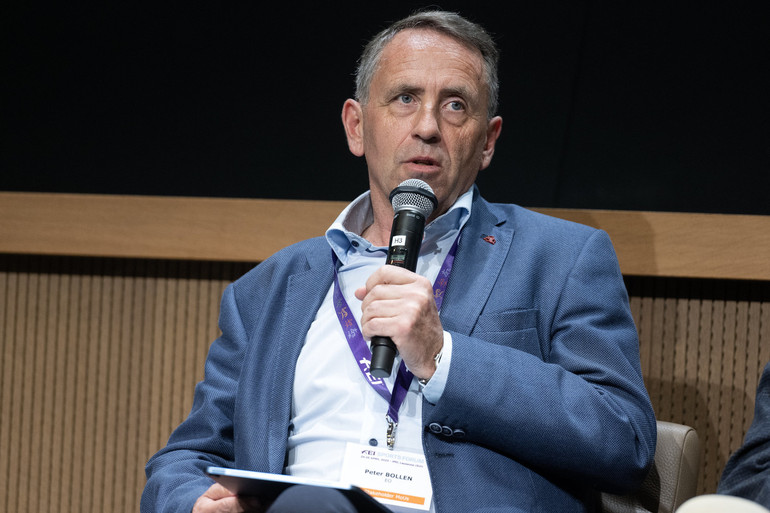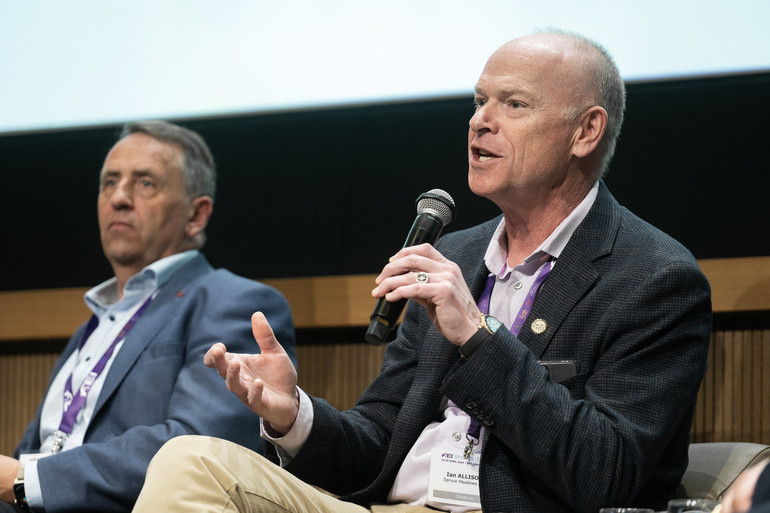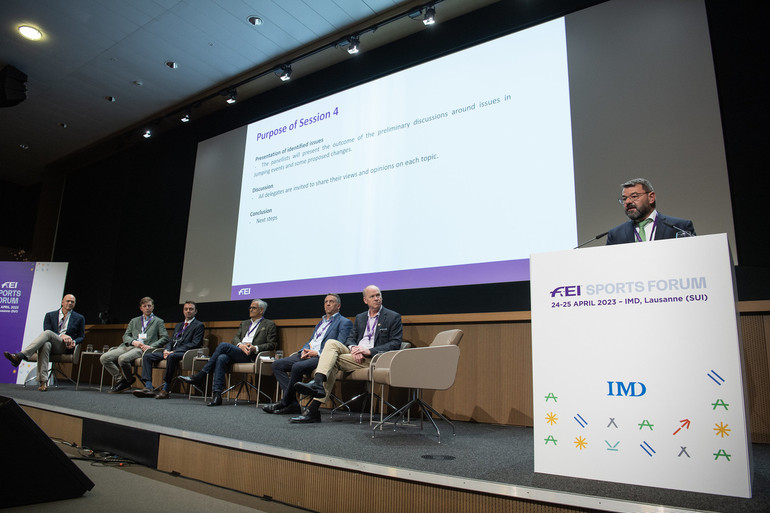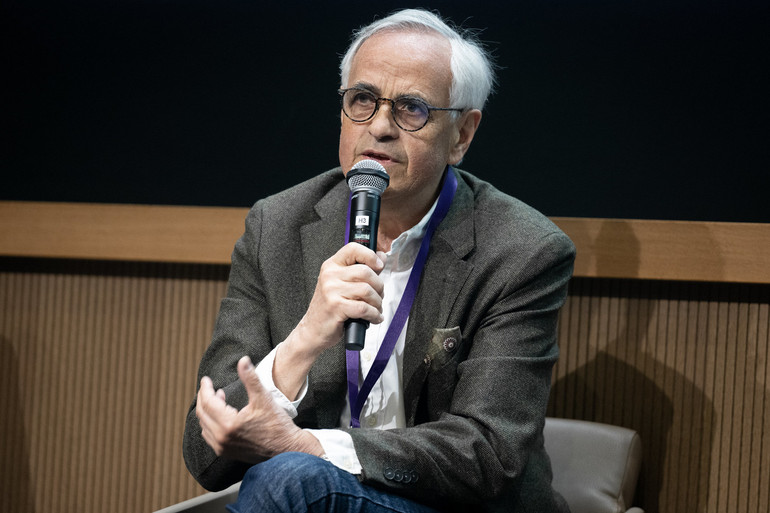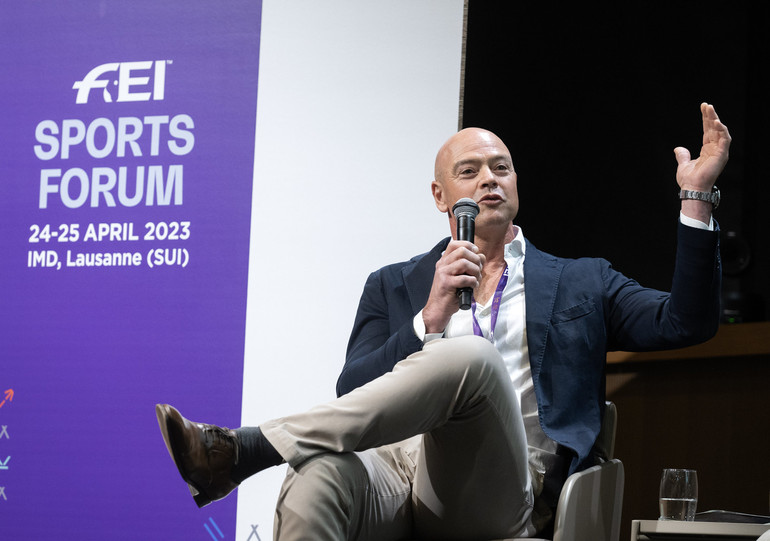“Do we want to give a chance to the unique shows?” Peter Bollen, President of the Equestrian Organisers, asked as session four of the 2023 FEI Sports Forum in Lausanne, Switzerland, got underway earlier this week. The session was dedicated to an open discussion on the cost of jumping events, with athletes, owners, officials and organisers participating, and it was moderated by FEI Secretary General Sabrina Ibáñez. A panel consisting of Bollen, François Mathy Jr. (Vice-President of the International Jumping Riders Club, IJRC), Ian Allison (1st Vice President of the Equestrian Organisers), Dominique Mégret (President of the Jumping Owners Club, JOC), Ali Küçük (Secretary General of the International Jumping Officials Club, IJOC), and Gaj Riossa (Representative of the International Jumping Riders Club, IJRC) led the conversation.
“The costs for everyone involved in our sport have increased dramatically over the past few years,” FEI Secretary General Sabrina Ibáñez began. “We felt at the FEI that it was extremely important to have our most important bodies to present the concerns, and maybe, possible solutions, with the stakeholders themselves – who are most affected. It is important for us not to come up with solutions, but to have them discuss amongst themselves and as well present what these possible solutions could be.”
Higher standards, higher costs
“From the side of the organisers, if you look to the last three-four years, it’s more and more financial challenges,” Peter Bollen said. “After the EHV-outbreak, we got extra biosecurity measures, which makes that we need to have extra officials and also build extra infrastructure. The inflation of the last two years increased the costs, not only energy costs and warming costs but also labour costs and infrastructure costs – averaged by 20-30% for each organiser. Last year, we got an increase of remuneration for the officials.”
Examples of increased costs:
- Following the EHV-1 outbreak in Europe back in 2021, the biosecurity measures in the FEI Veterinary Regulations were tightened. Today, organisers are for example meant to comply with pre-event venue preparations – such as disinfecting and sealing boxes prior to arrival of horses – and carry out veterinary examinations upon arrival. Some of the measures introduced require more human resources than prior to the EHV-1 outbreak, and have contributed to increased costs.
- In 2022, the per diem for the officials was increased from a rate of 120 Euro – to now be at between 150-250 Euro per day in Europe and North America for those officiating at 2-5* level. The rate depends on the star-level of the event, and what role the official has.
“The standards that are required for the shows are increasing every year, by the riders, also by the grooms, public, the officials, and also by the FEI, which increase the cost of the shows of course,” Bollen continued. “Then with the new measures we will have to take for sustainability, horse welfare… we expect that there will also come extra cost. We see an increase of no-shows at a lot of shows and often these stables that stay empty are extra cost for the organiser and so on and so on. Besides that, due to the financial insecure times, it is hard to find new sponsors to cover these extra costs and we even see that existing sponsors are reducing their budgets.”
“The last years, we have seen a trend,” Bollen went on. “A trend in the show market that I would say unique shows – and I mean shows that are organised once a year, with of course because of that very high infrastructure costs, but also with high quality sport and a lot of public – are suffering, and are even disappearing in some countries."
Do we want to evolute the sport to what is happening now, or do we want to give a chance to the unique shows?
"These shows are also FEI shows; like the Nations Cup and World Cup are included in these kind of quality shows," Bollen contnued. "And then on the other side, we see the fixed international infrastructures – like Hubside, Oliva, Riesenbeck, Arezzo, Sentower, Peelbergen and so on – those shows are doing pretty good, they organise more and more, but without public – so there is not really public attendance. So, my question is; where do we want to go with our sport in the future? Do we want to evolute the sport to what is happening now, or do we want to give a chance to the unique shows? And to give them a chance, the only way would be to be careful with the extra cost. We put every year extra cost on the shows, and to create some incentives for extra income for the shows – that is the only way these shows can continue in the future.”
Sport is going to the show to compete
“What difference does it make for the organiser, when they get a good crowd, spectators, compared to not – how much income can that generate for the show?” Jessica Kürten, Chair of the FEI Athletes Committee, asked.
It is quite disappointing to see a lot of riders going to competitions just to get a nice video
“Because we see that those competitions, where there are spectators, they are living, and they are living very, very well. Do we as riders – and I include myself in that even though I am not riding – do we have to look at ourselves, what we are doing when we go to competitions? It used to be that we spoke with our owners and said, is this horse ready for international competition, is this horse able to win something at the show? And we went to the show to compete. For me, personally, it is quite disappointing to see a lot of riders going to competitions just to get a nice video. And I don’t think that is sport, I think sport is going to the show to compete, and I think then we would be able to generate more spectators if more riders were competing.”
Fantasy fees
As the President of the Jumping Owners Club, Dominique Megret shared the perspective of the owners on the growing costs: “You have all to be aware and understand, that a very large portion of the costs are borne by the owners obviously – either directly or through the invoicing of their riders. Therefore, we are very keen to have these costs controlled and not increased too much in the future. We fully understand that we need motivated organisers, and we need shows to work. That means, that in the end, what we have to find, all together, is a balance – between our requirements, between the riders’ requirements, and the organisers’ requirements.”
“The riders need the shows, and the shows need the riders,” Francois Mathy Jr., Vice President of the IJRC, pointed out. “A lot of riders are also owners, so we completely share the same concern.”
The sentence you hear, is “cash or credit, cash or credit, cash or credit?” - because most of the riders going there, they are paying the bills
“But really, where do we want the sport to go?” Mathy Jr. asked. “When you stand in the line – and I am more talking about two-star and three-star level, as five-star level is not so much the case – when you stand in the line after the show for the bill, you have three people doing the accounts and the sentence you hear, is “cash or credit, cash or credit, cash or credit?” – because most of the riders going there, they are paying the bills. And then suddenly you have the winner, who has won enough prize money to pay for his bills – and this is the exception. This is the thing; when the young riders are starting, you cannot do this every week. We want to see if we want to leave this sport open for young riders, good promising riders who have medium potential to reach our sport, to be stars, or if we want to aim to the American model, where actually if you don’t have the money, it is going to be really, really hard – maybe impossible – to live your passion of the horses.”
Entry fees in numbers for 2023:
-
The entry fee in Europe at CSIYH level is 330 Euro per horses, at CSI1* and CSI2* level it is 440 Euro per horse, at CSI3* level it is 495 Euro per horse, at CSI4* level it is 605 Euro per horse and at CSI5*-W WEL it is 495 Euro per horse. Regular CSI5* events have no entry fee. On top, there are multiple other fees that need to be covered by the breeders/owners/riders – such as for example manure disposal, MCP, truck parking, truck electricity, etc.
-
In North America, the sum of the entry fee for three horses and all compulsory fees charged may not exceed 4% of prizemoney on CSI1* and CSI2* level, 3% on CSI3* level, 2% on CSI4* level and 1% on CSI5* level, while CSI-W events’ entry fees have to be according to World Cup Rules.
-
All CSIOs worldwide – on all star-levels – have an entry fee of 605 Euro.
-
At CSI5* events in Europe and North America, meals and accommodation for athletes and grooms is on the expense of the OC, while at all CSIOs worldwide, meals and accommodation for athletes, grooms and team vets is on the expense of the OC.
“It is really important to understand that the entry fee is not a set entry fee, it is a maximum entry fee,” Mathy Jr. continued. “However, basically all the shows have that maximum entry fee and the prize money is minimum prize money, or maximum prize money. So, there is also a way to have discussions; should the entry fee be related to the prize money or not? So that is the one thing, but basically what appeared in the last few years, because I think this amount of entry fee that could not move so much, is the fantasy fees that arrived. You see a program – the only rule is that it needs to be set in the schedule and approved, and now we have a list of different cost that some organisers – and I must say some – are setting on the rider’s bill and that can come from parking the truck, parking the car, riding in the ring, if you arrive too late… It is a never-ending story and there is no limit to that list and no limit to that price.”
A global framework
“The key is going to be finding that framework that Francois alluded to, that fits not only the star-levels but the disparity in the markets where our sport operates around the world,” the 1st Vice President of the Equestrian Organisers, Canada’s Ian Allison said.
We have to come with a solution that fits within the framework where organisers can be sustainable
“We all understand the pathway of the young horses and the young riders. We understand that in some markets of the world things are working tremendously well but also within those markets there are inequities that are, I’d say from some organisers, there has been work-arounds that have not looked good upon any of us. But I do think that we have had progressive dialogues and innovative thinking and we have to come with a solution. And we have to come with a solution that fits within the framework where organisers – wherever they happen to be wanting to plant the roots of this sport for the horses and the riders – can be sustainable.”
In 2021, the US Equestrian Federation pointed out to the FEI how the rates for converting prize money from CHF to USD – a system that had been in place since 2012 – had gotten out of sync with the reality of the financial exchange rates.
During the fourth session of the 2023 FEI Sports Forum in Lausanne, FEI Chief Financial Officer Claude Praz provided a detailed overview (available in the FEI Documents Library) of the financial situation, as well as proposals from FEI – which he emphasised were proposals and would require discussion and consensus amongst the community.
In an update that followed after the Sports Forum, the FEI detailed the situation:
"With the prize money evolving in line with inflation, it had led to a situation where for a CSI 5* event, the percentage difference for Europe was now at -20% while for the USA it was +19% of the total prize money required, reflecting a clear need for adjustment."
"A proposal from the FEI for 2024, would be to break away from CHF, and go forward with only two currencies – the Euro and the USD – given that roughly 70% of event prize money is paid in Euro, followed by USD. The Euro would be established as the new base currency and the USD as the second currency, which would be set at today’s exchange rate of 1.10, and help to largely balance out the discrepancies currently experienced."
"This new system would evolve in two ways. From August 2023 through to July 2024, the USD exchange rate would be monitored on a monthly basis, of which the average rate of the year would then be used. Secondly, a 5% threshold band would be applied, meaning that if the yearly average exchange rate did not increase or decrease by more than 5%, nothing would change. This way of proceeding would reduce the frequency of change, bring stability and avoid erratic fluctuations. In September 2024, calculations would then be adapted as per the above. FEI-CFO Claude Praz reiterated once again that this was a proposal, and that should this model be approved then it would also be applied to the prize money requirements for Longines Ranking competitions."
To take discussions further and find sustainable solutions, the FEI has decided to create a working group involving its various stakeholders. The working group is to be composed of two EO representatives, two IJRC representatives, one IJOC representative, one JOC representative, one IGA representative and two FEI representatives.



